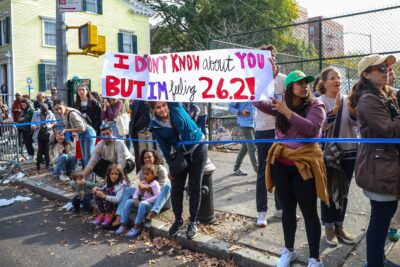Musical Map Of The USA: Georgia—The Allman Brothers

Georgia roads are made for rolled-down windows, for the glare of summer bouncing off a windshield, for tape decks in a sun-cracked dashboard. When I was in high school, back when first I knew people my own age who drove their own cars, there was a rule about accepting a ride. Always look in the center console or the glove box. Count the cassette tapes. If you found more Lynyrd Skynyrd than Allman Brothers, get out of the car, find another way home. Yes, both bands started in Jacksonville, right over the state line in Florida, but only the Allman Brothers picked up and relocated to Macon, Georgia.
If you want to know what Georgia sounds like, listen to Macon. Athens sounds like Athens and Atlanta sounds like Atlanta, but if there is anything like a Georgia Sound, it comes from Macon. Macon is far enough from the big city to escape its looming shadow. There’s no denying where you are. Macon is unadulterated Central Georgia, rural at its very core. It’s easy to dismiss a rural life, to diminish how freeing lowered expectations can be in the right hands given enough inspiration.
Macon gave us Richard Penniman. Born in 1932, Richard was skinny and small of frame. Everyone called him “Little.” His father sold bootleg moonshine, ran a nightclub, and was a deacon in the church where Richard learned to sing loud and sing often. Discovered selling Cola-Cola at the local auditorium, Richard Penniman from Macon became Little Richard. “Long Tall Sally” was his first number one single in 1956. From then on, Little Richard never stopped falling in and out of love with rock & roll, running back and forth to the church that brought him up.
Otis Redding was born in 1941 and grew up in Macon. The son of a sharecropper, he learned to sing in church, just like Little Richard. He sang gospel songs on the radio for $6 a Sunday. A teenaged Otis won a talent show by covering a Little Richard song, walking away with a $5 grand prize and an invitation to front a band called The Mighty Panthers. Redding recorded “These Arms of Mine” in 1962, bought 300 acres of Macon farmland just three years later. He called it the Big O Ranch.
After the success of their debut album, The Allman Brothers Band was courted by executives in Los Angeles and New York, all of them insisting they move to a bigger city like a proper rock & roll band. Instead, the Allmans bought a big house by a lake in Macon and gave it a name: Idlewild South.
Georgia sounds like Little Richard, Otis Redding, and The Allman Brothers Band. The line from Little Richard to Outkast’s Andre 3000 is clear and direct. Athen’s Drive-By Truckers follow a path blazed hard and deep by The Allman Brothers Band. And every performer wants to take the stage and shake like the late, great Otis Redding.
I’ve travelled along Interstate 75 for much of my life, mostly back and forth across the northwest corner of Georgia from just below Chattanooga to Atlanta. There’s no part of that stretch that’s unfamiliar to me. I know the billboards and notice when they change. There is an inevitability to I-75, to knowing which exit is the one to take you home, to get you to work, to get to what’s next. It’s just so long, that Interstate. For over 355 miles, I-75 South splits Georgia in a jagged line down the middle. The Interstate cuts through Dalton, Calhoun, the big city of Atlanta, Macon, and eventually Valdosta before crossing into Florida. About an hour or so below Atlanta, I-75 shifts sharply to your driving left, and you’re given a choice. You can leave I-75 at Macon, head east along I-16. I-16 promises an ocean if you keep going, but you have to choose. Macon forces a decision.
When my girlfriend came down South from NYC to visit me for the very first time, we planned a road trip. When I mapped out our journey from Atlanta to the Georgia coast, I peppered our mostly interstate route with diversions along highways and two-lane blacktops. Only after the mapping was done did I realize we would follow the route of a certain inflammatory March to the Sea. I’ve a dark sense of humor and found this hilariously appropriate, so I made us a playlist for the drive, and named it “Sherman’s March.” It opened with The Allman Brothers Band’s Eat A Peach, an album released the year I was born. I pressed play as we left Atlanta.
Eat A Peach is filled end to end with music that feels like really good driving, over an hour’s worth. A mix of studio tracks and live recordings, Eat A Peach came about through tragedy, a brave effort from a band uncertain of their future. Duane Allman, the eldest Allman Brother of two, died in a motorcycle crash only months after the skyrocketing success of At Fillmore East, a live double album affordably “people priced” like a single album. Another band would’ve called it a day. The Allman Brothers didn’t. The album opens with “Ain’t Wastin’ Time No More.”
Duane’s younger brother, Gregg, started writing “Ain’t Wastin’ Time No More” months before Duane’s passing, but the lyrics came after, a reflection on loss and the importance of right now.
You don’t need no gypsy to tell you why /
You can’t let one precious day slip by.
Despite my mapped efforts to stray from the Interstate during our road trip, we kept to I-75 South for the entire album, leaving Atlanta and passing through smaller towns like McDonough and Griffin. The last track on Eat A Peach, an instrumental called “Little Martha,” faded out, and a few miles later we were in Macon.
We let the left-wise drift of the Interstate take us further east, leaving I-75 South for I-16, heading to Savannah and the ocean, leaving the inevitability of the well-known behind.
This is one of more than 50 posts that make up our musical map of the United States, published by region—the West, Midwest, South, and Northeast—by writers who have strongly associated a song with a state.
[sc name=”nattysaw5″ ]
You might also like 




















